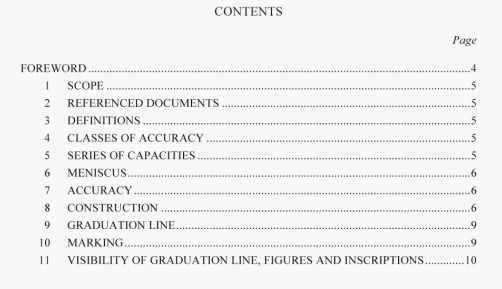AS 2164:2003 pdf – Laboratory glassware-One-mark volumetric flasks.
There may be an enlargement of diameter in the neck below the ground joint to enable better mixing of liquid.
8.5 Stopper
The stopper. if provided, shall be a good fit in the flask neck and be of glass, solid or hollow blown, or of a suitably inert plastic material.
NOTE: The stopper should be constructed with a flat top to allow the wet surface to stand free from other surfaces when the stopper is not in place in the flask.
8.6 Dimensions
Volumetric flasks shall comply with the dimensions shown in Tables 2 and 3. these dimensions being considered to be essential for accuracy and convenience in use. The recommended dimensions listed in Tables 2 and 3 are only approximate and provide guidance because they have proved satisfactory in use. The graduation line shall be placed in the lower two-thirds of the neck of the flask, and shall he not less than the stated minimum distance from any point at which the neck begins to change in diameter.
9 GRADUATION LINE
The graduation line shall be a clean, permanent. uniform line, of thickness not exceeding 0.4 mm, lying in a plane parallel to the base of the flask and completely encircling its neck.
10 MARKING
10.1 General
The following inscriptions shall be permanentl3 marked on each volumetric flask:
(a) A number indicating the nominal capacity.
(b) The symbol ‘cm” or the symbol ‘mL’ to indicate the unit of volume.
NOTE: The I 000 mL, 2 000 mL and 5 000 mL flasks may, if desired, be inscribed in terms of the litre in place of the millilitre.
(c) The inscription ‘20°C’ to indicate the standard reference temperature.
(d) A suitable abbreviation to indicate that the flask has been adjusted to contain its indicated capacity.
(e) The letter or (where considered necessai). ‘11’ to indicate the class of accuracy of the volumetric flask and the tolerance in accordance with Tables 2 or 3. Wide necked flasks shall be marked sitli ‘Aw’ or ‘Bs’ and the tolerance.
(f) The maker’s or endor’s name or mark.
(g) lxcept for flasks made of soda glass, an indication of the type of glass used.
NOTE: This requirement may be satisfied by a glass manufacturer’s trademark, or by a suitable marking (such as ‘boro’ or ‘borosilicate’ in the case of borosilicate glass).
AS 2164:2003 pdf – Laboratory glassware-One-mark volumetric flasks
